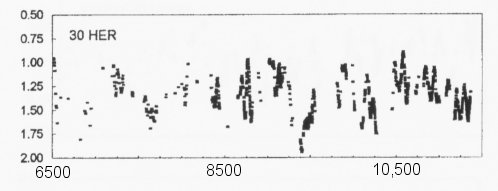 Thirty Her is seen to vary by up to a magnitude or so over the 30 years
of observation, with a principal period of 93 days.
The scale on the bottom is the "Julian Date" of 2440000 plus the
number that appears, where the Julian Date is the number of days
since January 1, 4713 BC of the Julian Calendar and is commonly
used for variable phenomena in astronomy. JD 2446500 corresponds
to March 11, 1986. The left-hand scale
expresses the difference between the apparent visual magnitude of
30 Herculis and a nearby comparison star. (From an article in the
Publications of the Astronomical Society of the Pacific
by J. R. Percy, J. B. Wilson, and G. W. Henry.)
Thirty Her is seen to vary by up to a magnitude or so over the 30 years
of observation, with a principal period of 93 days.
The scale on the bottom is the "Julian Date" of 2440000 plus the
number that appears, where the Julian Date is the number of days
since January 1, 4713 BC of the Julian Calendar and is commonly
used for variable phenomena in astronomy. JD 2446500 corresponds
to March 11, 1986. The left-hand scale
expresses the difference between the apparent visual magnitude of
30 Herculis and a nearby comparison star. (From an article in the
Publications of the Astronomical Society of the Pacific
by J. R. Percy, J. B. Wilson, and G. W. Henry.)
|
 Thirty Her is seen to vary by up to a magnitude or so over the 30 years
of observation, with a principal period of 93 days.
The scale on the bottom is the "Julian Date" of 2440000 plus the
number that appears, where the Julian Date is the number of days
since January 1, 4713 BC of the Julian Calendar and is commonly
used for variable phenomena in astronomy. JD 2446500 corresponds
to March 11, 1986. The left-hand scale
expresses the difference between the apparent visual magnitude of
30 Herculis and a nearby comparison star. (From an article in the
Publications of the Astronomical Society of the Pacific
by J. R. Percy, J. B. Wilson, and G. W. Henry.)
Thirty Her is seen to vary by up to a magnitude or so over the 30 years
of observation, with a principal period of 93 days.
The scale on the bottom is the "Julian Date" of 2440000 plus the
number that appears, where the Julian Date is the number of days
since January 1, 4713 BC of the Julian Calendar and is commonly
used for variable phenomena in astronomy. JD 2446500 corresponds
to March 11, 1986. The left-hand scale
expresses the difference between the apparent visual magnitude of
30 Herculis and a nearby comparison star. (From an article in the
Publications of the Astronomical Society of the Pacific
by J. R. Percy, J. B. Wilson, and G. W. Henry.)